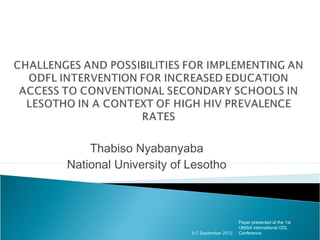Using odfl to increase access to secondary schools in lesotho nyabanyaba
- 1. Thabiso Nyabanyaba National University of Lesotho Paper presented at the 1st UNISA international ODL 5-7 September 2012 Conference
- 2. ’üĮ Project ŌŚ” SOFIE (Strengthening open and flexible learning to support educational access in contexts of high prevalence rates in SADC countries) ’üĮ Aims ŌŚ” improving retention and ŌŚ” increasing access to learning ’üĮ Focus group ŌŚ” OVCs ŌŚ” Children affected by HIV and AIDS ’üĮ Using open and flexible learning strategies
- 3. ’üĮ Many children experience absenteeism before dropout, due to ŌŚ” Push out factors (in-school) ’é¢ Overcrowding in schools ’é¢ Teacher lack PSS and ability to cope with large classes ’é¢ Lack of infrastructure ’é¢ Curricular irrelevance ŌŚ” Pull out factors (out-of-school) ’é¢ Poverty ’é¢ Early marriage ’é¢ Impact of HIV and AIDS ’üĮ ODFL strategies have potential to support ŌĆśat-riskŌĆÖ students (Pridmore, 2006) ŌŚ” Offering opportunities for re-entry ŌŚ” Improving teacher understanding and empathy towards ŌĆśat-riskŌĆÖ
- 4. ’üĮ To what extent can barriers to access and attainment due to HIV and AIDS be addressed using ODFL as a complement to conventional schooling? ’üĮ DfID/Economic and Social Science Research funded ŌŚ” Institute of Education, London ŌŚ” Centre for Educational Research and Training, Malawi ŌŚ” Institute of Education, Lesotho ŌŚ” South African Institute of Distance Education ’üĮ Followed a mixed method approach in distinct phases ŌŚ” Phase 1: Situational analysis ŌĆō desk studies of policy, practices and factors influencing educational access ŌŚ” Phase 2: Multi-site, formative fieldwork of factors influencing educational access ŌŚ” Phase3: Development, trial and evaluation school-based intervention, incorporating ODFL
- 5. ’üĮ Pretest-Posttest Control Group design ’üĮ 20/20 Schools randomly assigned to either of two groups (matching). ’üĮ Both groups were administered questionnaires and test papers (Maths and English) ŌŚ” at the baseline (November 2008) and ŌŚ” following implementation (November 2009), but ŌŚ” only one group received the intervention package and training ’üĮ Additional qualitative data collected at various stages ŌŚ” Mid-term monitoring visit in August 2009 ŌŚ” Concurrent with post-intervention visits (November 2009) ŌŚ” District-level evaluation workshops held in January 2010.
- 7. ’üĮ School-in-a-box: ’üĮ Club leader manual ’üĮ Self -Study guides (English & Mathematics) ’üĮ Form B Textbooks (English & Mathematics) ’üĮ Dictionary ’üĮ English readers ’üĮ Supplementary readers on child rights, child labour and gender violence. ’üĮ HIV&AIDS board game ŌĆśChoices & DecisionsŌĆÖ ’üĮ Writing materials ’üĮ Wind-up Radio ’üĮ School-in-a-bag: ’üĮ School bag (rucksack) ’üĮ Mathematical Instrument set ’üĮ 2 Notebooks, a pen and a pencil
- 8. Sample Sampled students' status 1200 Non-orphans 1000 2% Single parents 800 15% 6% Paternal orphans female 600 Maternal orphans Male 53% 400 21% Double orphans 3% Abondoned 200 No data 0 Intervention Control
- 9. ’üĮ The attendance and progression rate for boys is worse than girls in general, especially in rural areas. ŌŚ” Related to boys being called upon to look after animals. ŌŚ” Initiation ’üĮ However, girls experience more disruptions as they progress ŌŚ” a result of girls being called on to look after sick members of families and siblings, ŌŚ” early marriage to escape the burden of poverty at home. ’üĮ Disruptions also associated with the perceived low quality of education ’üĮ Results ŌŚ” Inequitable access ŌŚ” Poor efficiency ŌŚ” Low quality ŌŚ” Inadequate output/completion
- 10. Control schools Intervention schools Mean Mean File number N Rank N Rank SCR:/English score Baseline 1841 1667.63 1819 1708.43 End-of-intervention 1629 1812.21 1578 1688.13 Total 3470 3397 SCR:/Maths score Baseline 1842 1867.56 1818 1680.78 End-of-intervention 1596 1548.62 1559 1698.59 Total 3438 3377 P:/Absenteeism Baseline 1075 1226.67 1205 1332.71 End-of-intervention 1371 1221.01 1439 1313.95 Total 2446 2644
- 11. ’üĮ Slight decline in the scores for English, ’üĮ Slight increase in the mathematics scores ’üĮ Slight decline in the rate of absenteeism ’üĮ None statistically significant ’üĮ Difference in maths performance was statistically significant
- 12. Mean Sum of ID:/Student status N Rank Ranks S:/repeated Form A club member 224 149.5 33488 in 2008 non-club member 74 149.5 11063 Total 298 S:/Absenteeism club member 224 151.33 33899 non-club member 74 143.95 10652 Total 298 SCR:/English score club member 220 144.86 31869.5 non-club member 73 153.45 11201.5 Total 293 SCR:/Maths score club member 216 151.69 32764 non-club member 73 125.22 9141 Total 289
- 13. ’üĮ Club-members did significantly better than similar students in maths ’üĮ Serious inequalities and obstacles remain ’üĮ Conclusion about intervention ŌŚ” Had no impact to negative impact on English ŌŚ” No impact on attendance could be found (inadequate intervention) ŌŚ” Reduced dropout rates marginally ŌŚ” Had a significant impact on maths performance ŌŚ” Schools became better places for learning for OVCs ’é¢ Reported impact on teacher empathy towards OVCs due to PSS training ŌŚ” Better societal understanding on situation of OVCs
- 14. ’üĮ Need for increased monitoring of attendance ŌŚ” Particularly for OVCs at secondary schooling ’é¢ Lack of understanding and monitoring of childhood and their issues ’üĮ Need for increased PSS support for OVCs ŌŚ” Points to the impact of HIV and vulnerability ’é¢ Child-headed and grandparents households ’üĮ Need to work through teacher formations in intervention ŌŚ” Successful link with Maths teachersŌĆÖ association resulted in cooperation ’üĮ Current and emerging socio-economic challenges call for more research and development of ODFL to complement conventional approaches Full papers available on: http://sofie.ioe.ac.uk/publications.html licensed under a Creative Commons Attribution- NonCommercial 3.0 Unported License













